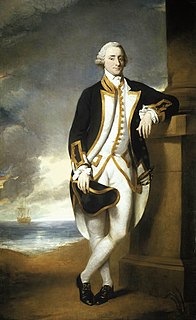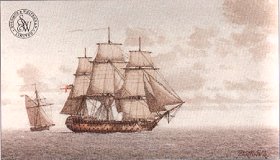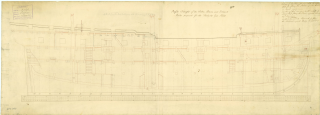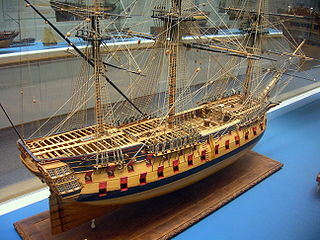
HMS Victorious was a 74-gun third-rate ship of the line of the Royal Navy, launched at Bucklers Hard on 20 October 1808, five years after the previous HMS Victorious had been broken up.

Admiral Sir Hugh Palliser, 1st Baronet was a Royal Navy officer. As captain of the 58-gun HMS Eagle he engaged and defeated the French 50-gun Duc d'Aquitain off Ushant in May 1757 during the Seven Years' War. He went on to serve as Commodore Governor of Newfoundland, then Controller of the Navy and then First Naval Lord. During the American Revolutionary War he came into a famous dispute with Augustus Keppel over his conduct as third-in-command of the Channel Fleet at the inconclusive Battle of Ushant in July 1778; the dispute led to Palliser being court-martialled, although he was subsequently acquitted. In retirement Palliser became Governor of Greenwich Hospital.

Scipion was a 74-gun French ship of the line, built at Lorient to a design by Jacques Noel Sane. She was launched as Orient in late 1798, and renamed Scipion in 1801. She was first commissioned in 1802 and joined the French Mediterranean fleet based at Toulon, in the squadron of Admiral Leissègues. Consequently she was one of the ships afloat in that port when war with England reopened in May 1803. She participated in the Battle of Cape Finisterre and the Battle of Trafalgar. The British captured her in the subsequent Battle of Cape Ortegal. In 1810 she participated in the Java campaign, which in 1847 earned her surviving crew the Naval General Service Medal. She participated in the blockade of Toulon in 1813 and was paid off in 1814. She was broken up in 1819.

HMS Edgar was a 74-gun third-rate ship of the line of the Royal Navy, that saw service in the American Revolutionary, French Revolutionary and Napoleonic Wars. Launched in 1779, she fought in the battles of Cape St Vincent and Copenhagen, two of the major naval engagements of the wars.

HMS Modeste was a 64-gun third rate ship of the line of the Royal Navy. She was previously the 64-gun Modeste, of the French Navy, launched in 1759 and captured later that year.

HMS Castor was a 32-gun Amazon-class fifth-rate frigate of the Royal Navy. She served during the French Revolutionary and Napoleonic Wars. The French briefly captured her during the Atlantic Campaign of May 1794 but she spent just 20 days in French hands as a British ship retook her before her prize crew could reach a French port. Castor eventually saw service in many of the theatres of the wars, spending time in the waters off the British Isles, in the Mediterranean and Atlantic, as well as the Caribbean.

HMS Lowestoffe was a 32-gun fifth-rate frigate of the Royal Navy. Built during the latter part of the Seven Years' War, she went on to see action in the American War of Independence and the French Revolutionary War, and served often in the Caribbean. A young Horatio Nelson served aboard her shortly after passing his lieutenant's examination.

Sir Edward Buller, 1st Baronet was an officer of the Royal Navy who served during the American War of Independence and the French Revolutionary and Napoleonic Wars.

HMS Pallas was one of the three 36-gun Venus-class fifth-rate frigates of the Royal Navy. She was launched in 1757 and initially served in Sir Edward Hawke's fleet blockading the coast of France where she fought at the Raid on Cherbourg and in the Battle of Bishops Court. She later served for a number of years in the Mediterranean Sea before moving to serve off the coast of Africa between 1774 and 1776 where she protected the isolated British colonies. In 1778 she joined the Newfoundland Station and participated in the attack on Saint Pierre and Miquelon. Pallas returned to the English Channel after this and assisted in destroying a French invasion force intended for the Channel Islands in 1779 before briefly serving on the Jamaica Station. In 1783 she was beached on São Jorge Island after she was found to be heavily leaking; she was burned there on 24 February.

HMS Active was a 28-gun Coventry-class sixth-rate sailing frigate of the Royal Navy, launched in 1758. She was one of the captors of the Spanish ship Hermione. After Hermione surrendered, her captors found that she carried a large cargo of gold and silver that would lead to the greatest single amount of prize money awarded to the crew of a British warship.

HMS Aquilon was a 28-gun Coventry-class sixth-rate frigate of the Royal Navy. Launched in 1758, she saw active service against the French during the Seven Years' War, capturing seven enemy vessels in the first eight months of 1761. She was declared surplus to Navy requirements and sold into private hands in 1776.
Robert Linzee was an officer of the Royal Navy who served during the American War of Independence, and the French Revolutionary and Napoleonic Wars.
Sir Henry Heathcote was an officer of the Royal Navy who served during the French Revolutionary and Napoleonic Wars.
HMS Siren was a sixth-rate post ship of the British Royal Navy, in commission between 1745 and 1763, seeing action during the War of the Austrian Succession and the Seven Years' War.

John Loring was an officer in the Royal Navy who served during the American War of Independence and the French Revolutionary and Napoleonic Wars.

The action of 17 July 1761 was a naval engagement fought off the Spanish port of Cádiz between a British Royal Navy squadron and a smaller French Navy squadron during the Seven Years' War. British fleets had achieved dominance in European waters over the French following heavy defeats of French fleets in 1759. To maintain this control, British battle squadrons were stationed off French ports, as well as ports in neutral but French-supporting Spain which sheltered French warships. In 1761, two French ships, the 64-gun ship of the line Achille and 32-gun frigate Bouffone were blockaded in the principal Spanish naval base of Cádiz, on the Southern Atlantic coast of Spain.

HDMS Grønland (Greenland) was a ship of the line of the Dano-Norwegian Navy, built in 1756 and decommissioned in 1791. Grønland spent considerable time in the Mediterranean Sea, where she protected Danish merchant convoys. Grønland took part in the bombardment of Algiers in 1770 but otherwise did not see any action in battle. It is noted in the Danish Admiralty's papers that she was an unusually seaworthy ship.
HMS Thunder was an 8-gun bomb vessel of the Royal Navy, previously the mercantile Dasher. Dasher, launched at Bideford in 1800, had made two voyages as a slave ship before the Royal Navy purchased her in 1803 and renamed her HMS Thunder. Thunder served in the Mediterranean and the Baltic; among other actions, she participated in a battle and one single-ship action, each of which resulted in her crew later qualifying for clasps to the Naval General Service Medal (1847). The Navy sold her in 1814.
Captain Sir John Hamilton, 1st Baronet was a Royal Navy officer of the eighteenth century. He joined as a captain's servant in HMS Rippon in 1740. Hamilton fought in the War of Jenkins' Ear at the Battle of Cartagena de Indias in 1741 and then transferred to HMS Alderney where he participated in the unsuccessful Invasion of Cuba. He was promoted to midshipman in HMS Success in 1742, and was promoted to lieutenant while serving on HMS Tartar in 1747. Having served in a variety of ships as a lieutenant, Hamilton was promoted to commander in 1762. After initially commanding HMS Cormorant he served in HMS Zephyr and HMS Merlin on the Newfoundland Station before being promoted to post captain in 1766.

HMS Aeolus (1758) was a 32-gun Fifth-rate frigate of the Royal Navy. In 1800, she renamed as HMS Guernsey.















